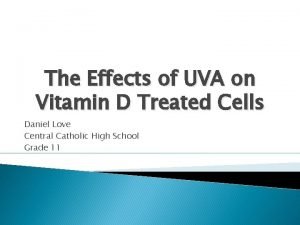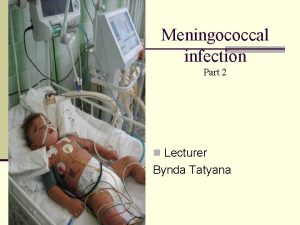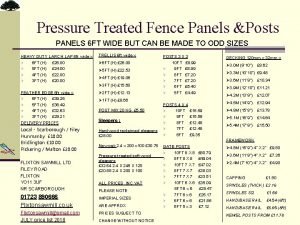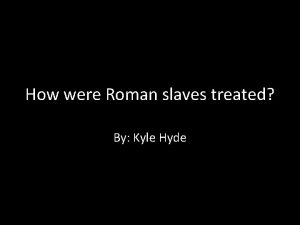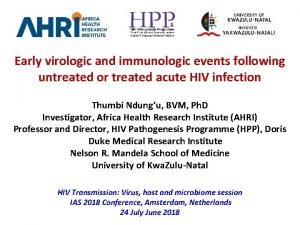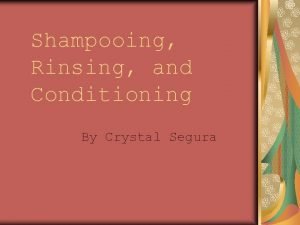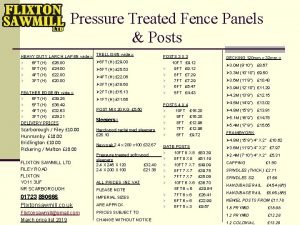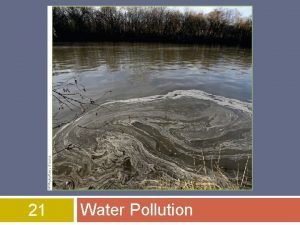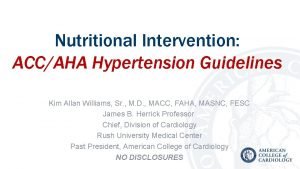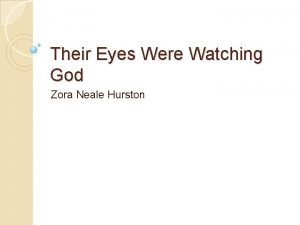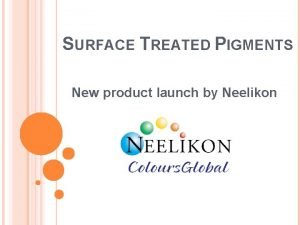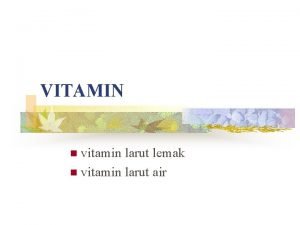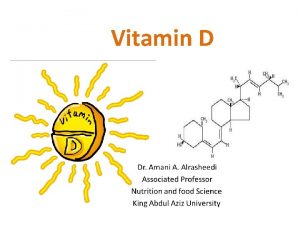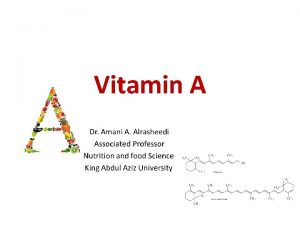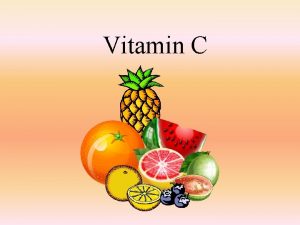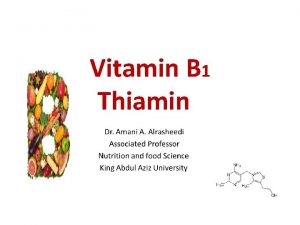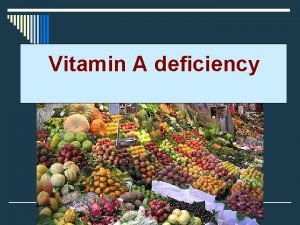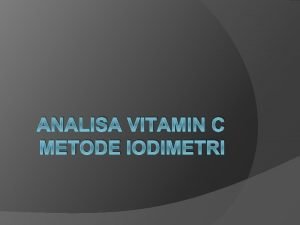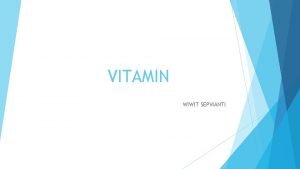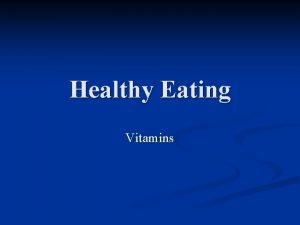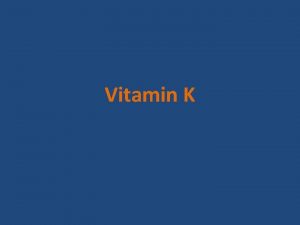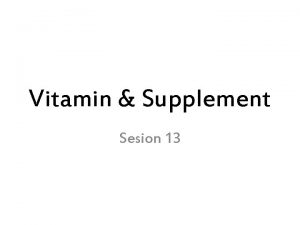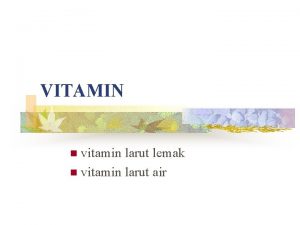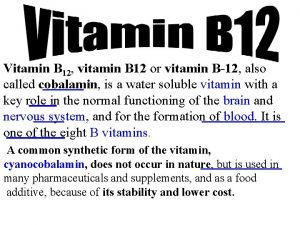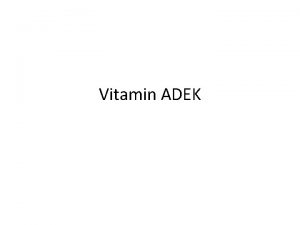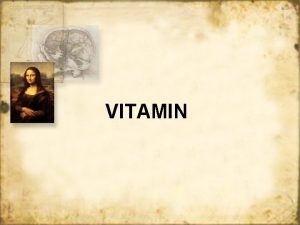The Effects of UVA on Vitamin D Treated





















- Slides: 21

The Effects of UVA on Vitamin D Treated Cells Daniel Love Central Catholic High School Grade 11

Oxidative Stress • Caused by X-Rays and UV Rays • Stress causes an increase in free radical production • Cell degeneration possible • Other effects include an increased risk of cancer or death

Ultra Violet Radiation � Radiates � Most � Have from the sun. radiation is stopped by the ozone layer shorter wavelengths than visible light, thus are more powerful � Waves range from 100 nm to 400 nm

Effects of UV Radiation � � In humans, causes sunburn, nausea, sun stroke and possibly skin cancer. FDA protection methods include sunscreen, hats, sunglasses, and antiradiation clothing. Can possibly cause dimers in a cell’s DNA, which leads to replication errors and mutations. �

Staphylococcus epidermidis � Gram positive bacteria. � Common surface symbiont in many mammals (including humans). � Most forms considered non-pathogenic. � Potentially pathogenic � Forms biofilms

Vitamin D � A group of fat-soluble secosteroids. � The body can synthesize it with adequate sun exposure. � Effects of supplementation are uncertain. � Needed for bone growth. � Liquid vitamin D is measured in IUs, which is the measurement of concentration. 4, 000 IUs per m. L.

Vitamin D Toxicity � Also called hypervitaminosis D. � Results � Can from excess vitamin D supplements. cause liver or kidney conditions. � Main consequence is a build-up of calcium in the bloodstream, known as Hypercalcemia

Purpose The purpose of this experiment is to determine whether vitamin D will significantly remediate the effects of UV radiation on S. epidermidis

Hypotheses Null Hypothesis- Vitamin D will have no significant effect on the survivorship of UV stressed Staph. Alternate Hypothesis- Vitamin D will have a significant effect on the survivorship of UV stressed Staph.

Materials � LB agar plates (0. 5% yeast extract, 1% tryptone, 1% sodium chloride) � Staphylococcous epidermidis � Sterile Dilution Fluid [SDF] (100 m. M KH 2 PO 4, 100 m. M K 2 HPO 4, 10 m. M Mg. SO 4, 1 m. M Na. Cl) � Sterile test tubes � Sterile spreader bars � Incubator � Ethanol � Bunsen � Vortex � Vitamin burner D (liquid supplement) � Micropipettes � Sterile Tips � Klett Spectrophotometer � Labeling tape � Labconco UVC Hood (254 nm UVC 0. 7 -0. 9 cm 2 at working surface) � UVA 50 watt lamp

Procedure UVA 1. Bacteria (Staph) was grown overnight in sterile LB Media. 2. A sample of the overnight culture was added to fresh media in a sterile sidearm flask. 3. The culture was placed in an incubator (37°C) until a density of 50 Klett spectrophotometer units was reached. This represents a cell density of approximately 10⁸ cells/m. L. 4. The cell concentration was then diluted to 10³ cells/m. L. 5. 0. 1 m. L of the cell concentration was added to the agar plate and exposed to UVA light at varying times. 6. The plates were incubated at 37°C overnight. 7. The resulting cell colonies were counted the next day. Each colony was assumed to have risen from one cell.

UVA Effects on S. epidermidis 237 245 248 251 P-Value=0. 309 Number of Cell Colonies 261 UVA Stressed Cells 0 5 10 Time of Exposure (min) 20 30

Procedure UVC 1. Bacteria (Staph) was grown overnight in sterile LB Media. 2. A sample of the overnight culture was added to fresh media in a sterile sidearm flask. 3. The culture was placed in an incubator (37°C) until a density of 50 Klett spectrophotometer units was reached. This represents a cell density of approximately 10⁸ cells/m. L. 4. Concentrations of Vitamin D were made in separate tubes with concentrations of 0% (control), 1%, and 10%. 5. The cell concentration was then diluted and added to each tube. The cells were exposed to the vitamin D for ten minutes 6. 0. 1 m. L was then plated from each tube. 7. The cells were then exposed to timed amounts of UVC radiation (0 s, 2 s, 5 s, 10 s, and 20 s) 8. The cells were incubated at 37°C overnight. 9. The resulting cell colonies were counted the next day. All colonies were assumed to have risen from one cell

Concentration chart Concentration 0% (Control) 1% 10% S. epidermidis 0. 1 m. Ls SDF 9. 9 m. Ls 9. 8 m. Ls 8. 9 m. Ls Vitamin D 0 m. Ls 0. 1 m. Ls 1 m. L Final Volume 10 m. Ls

Vitamin D UVC Remediation Effects P-Value (Whole Graph=9. 05239 E-56) P-Value=0. 00037 282 285 249 P-Value=0. 848 257 Number of Cell Colonies 249 Interaction=0. 0029 256 P-Value=0. 651 153 171 175 P-Value=9. 952 E-05 96 54 45 P-Value=0. 554 9 0 s 2 s 5 s UVC Exposure Time (sec) 0% D 10% D 10 s 12 20 UVC 10

Dunnett’s Test T-Crit = 1. 94 Concentration T-Value Significance 0 UVC, 1% Vitamin D 0. 54 Insignificant 0 UVC, 10% Vitamin D 4. 33 Significant 10 UVC, 1% Vitamin D 4. 64 10 UVC, 10% Vitamin D 1 Significant Insignificant

S. epidermidis Survivorship P-Value=9. 05239 E-56 350 LD 50= 5 UVC LD 50= 6 UVC LD 50=5. 5 UVC Number of Colonies 300 250 200 0% 150 1% 100 50 0 0 UVC 2 UVC 5 UVC 10 UVC Exposure time (sec) 20 UVC

Conclusions � The null hypothesis was rejected for concentrations of 1% Vitamin D with a 10 second Exposure. � Null Hypothesis can be accepted for all other concentrations � 1% Vitamin D was able to significantly remediate the UVC radiation. � UVA is much weaker than UVC and has a higher kill time.

Limitations � UVA radiation was not strong enough � UVA exposures weren’t long enough � Only 6 replicates � Only 4 exposure times � Only 1 wavelength used (UVC 250 nm) � Plating may not have been synchronized � Cannot analyze the health or growth rate of cells that recovered from radiation

Extensions � More replicates and concentrations � More wavelengths � Longer exposure times for UVA in order to generate a kill curve � Use UVB instead of UVA � Conduct an agar infusion test to simulate longer exposure

References http: //www. epa. gov/sunwise/doc/uvradiation. html http: //hps. org/hpspublications/articles/uv. html http: //earthobservatory. nasa. gov/Features/UVB/ http: //www. skincancer. org/prevention/uva-and-uvb http: //www. who. int/uv/faq/whatisuv/en/index 2. html http: //www. who. int/uv/uv_and_health/en/
 Uva and vitamin d
Uva and vitamin d Mucosya
Mucosya Flixton sawmill price list
Flixton sawmill price list How were roman slaves treated
How were roman slaves treated Treat others the way you would like to be
Treat others the way you would like to be He was treated like a and cast out from his community
He was treated like a and cast out from his community Biorad
Biorad How can governments ensure citizens are treated fairly
How can governments ensure citizens are treated fairly Circuit switching types
Circuit switching types After shampooing chemically treated hair tends to
After shampooing chemically treated hair tends to Flixton sawmill price list
Flixton sawmill price list Treat with sincerity
Treat with sincerity Water treated from sewage treatment plant
Water treated from sewage treatment plant Each packet is treated independently
Each packet is treated independently Blood pressure ranges
Blood pressure ranges Market forms of poultry
Market forms of poultry What is janie and joe's first impression of the town
What is janie and joe's first impression of the town Lithium hydroxide relaxer
Lithium hydroxide relaxer Surface-treated pigments
Surface-treated pigments Các châu lục và đại dương trên thế giới
Các châu lục và đại dương trên thế giới Chụp phim tư thế worms-breton
Chụp phim tư thế worms-breton ưu thế lai là gì
ưu thế lai là gì
